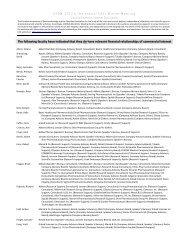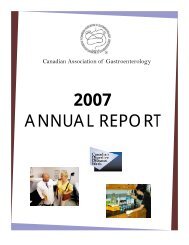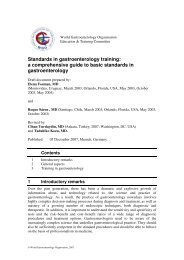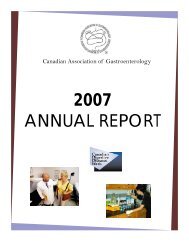Wait Times A Medical Liability Perspective - The Canadian ...
Wait Times A Medical Liability Perspective - The Canadian ...
Wait Times A Medical Liability Perspective - The Canadian ...
You also want an ePaper? Increase the reach of your titles
YUMPU automatically turns print PDFs into web optimized ePapers that Google loves.
10worst possible situation in which a numberof complicating, and possibly extenuating,circumstances converge to disadvantagethe patient.Given the physician’s responsibility toindividual patients, there remains considerablepotential for conflict with his/her as-yetundefinedresponsibilities to other persons onthe waiting list for care. For example, patientsrightfully expect their physician will act ontheir behalf to gain timely access to the careneeded. This gives rise to a potential situationin which a physician might be heldaccountable for not advocating stronglyenough for a patient faced with overly longwait times. Conversely, it might easily giverise to a difficult situation in which aphysician is open to accusations that he/sheadvocated too strongly for an individualpatient at the expense of others with a higherclinical prioritization.Government accountabilityMany stakeholders have advocated twomeasures to incorporate governmentaccountability for wait times – theestablishment of wait-times guarantees andthe withholding of funds when suchguarantees are not met. <strong>Wait</strong>-timesguarantees involve a commitment, on thepart of governments, to deliver treatmentwithin a publicly declared wait-time period.Should such treatment not be availablewithin the province/territory, thenprovinces/territories are expected to pay forthe treatment costs for patients who musttravel to other jurisdictions to receiveservices within the wait-time period.Over the past few years, a number ofprovincial/territorial governments haveestablished wait-times guarantees, either ontheir own volition or, as an outflow from the2007 federal budget, in conjunction with thefederal government. While generallyrestricted to a few selective procedures, theseguarantees represent a rapid evolution frombenchmarks to what are expected to beenforceable standards. For their part,provincial/territorial governments can holdregional and local health authoritiesaccountable through performanceagreements that include specific wait listreduction targets. In turn, it is not surprisingregional and local health authorities andinstitutions appear to be attempting to useaccess to facilities as a means through whichto hold physicians accountable for ensuringthat collective targets are met.Patient safety considerationsAny discussion concerning the effectivemanagement of treatment wait times mustinclude consideration of patient safety. It isforeseeable that efforts to reduce treatmentwait times and to create the most efficientsystem possible will generate concerns aboutpatient safety. <strong>The</strong>re are likely to be bothpositive and negative patient safetyimplications from efforts to reduce waittimes. On one hand, improved access shouldlead to better results as patients receive carein a more timely manner. On the otherhand, the rationing of time and resources toindividual patients in order to enhanceaccess for others may lead to negativeoutcomes. This creates a real dilemma forphysicians.Physicians should be cautious not to sacrificequality medicine in order to achieve highprocess rates. This may well add to frictionsbetween those responsible for managing thesystem and doctors trying to care for theirpatients. An increased emphasis on systemperformance and measurement is likely toexacerbate any such frictions. Courts,regulatory colleges and patients can beexpected to hold physicians accountable forhow they treated individuals – regardless ofthe pressures to “treat” waiting lists. Thisreality is unlikely to go away regardless ofwait-time benchmarks.
















